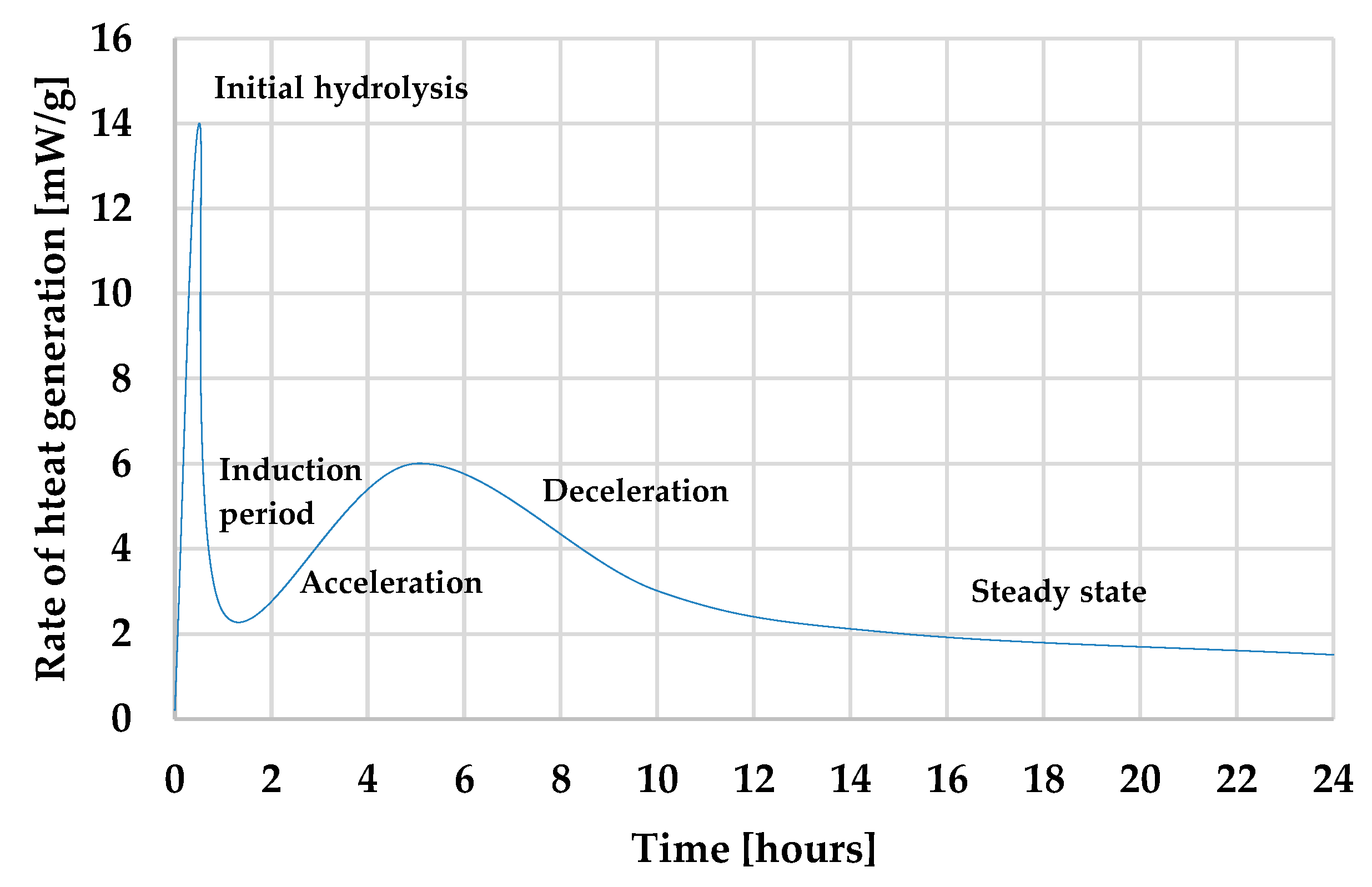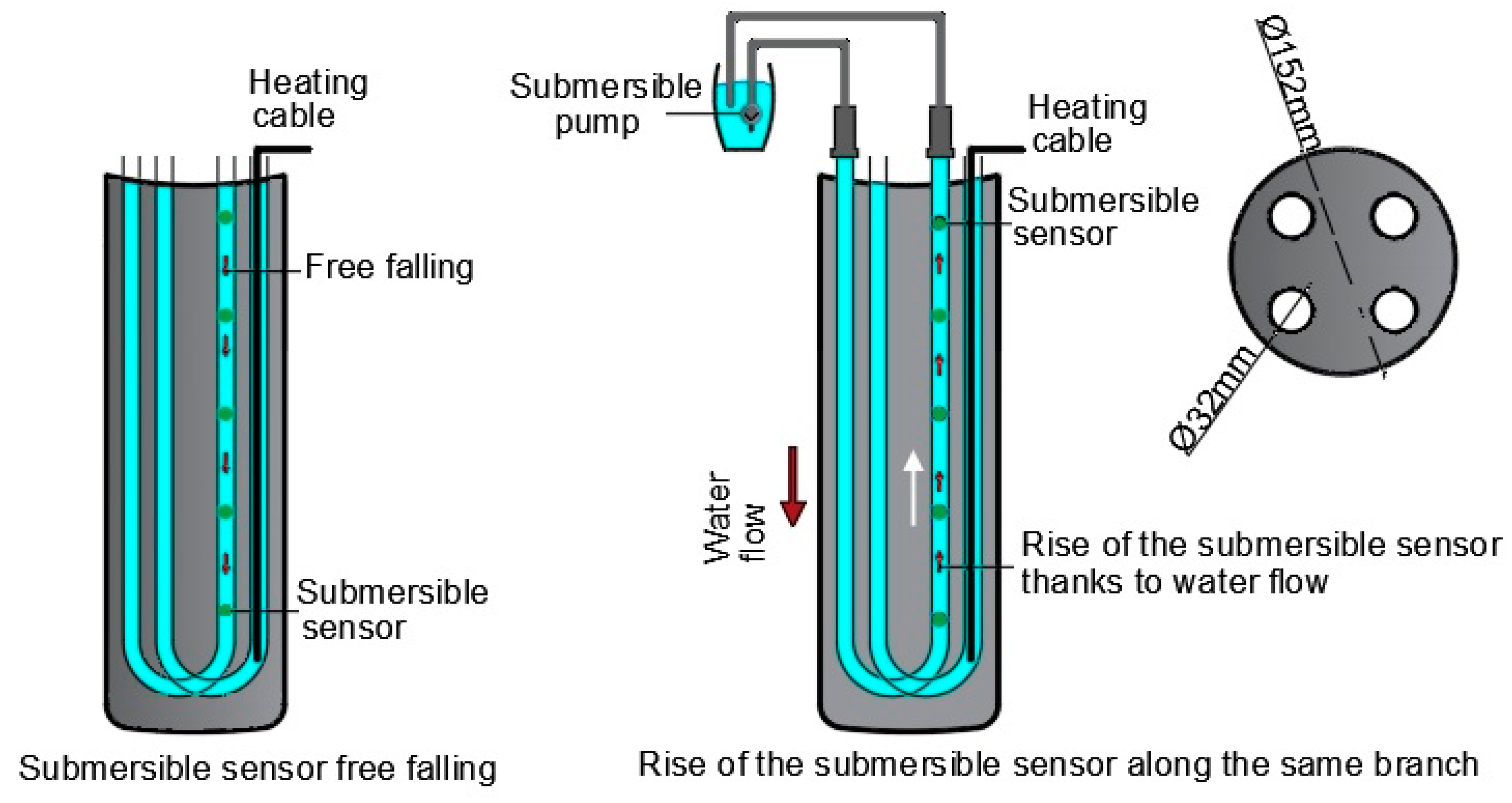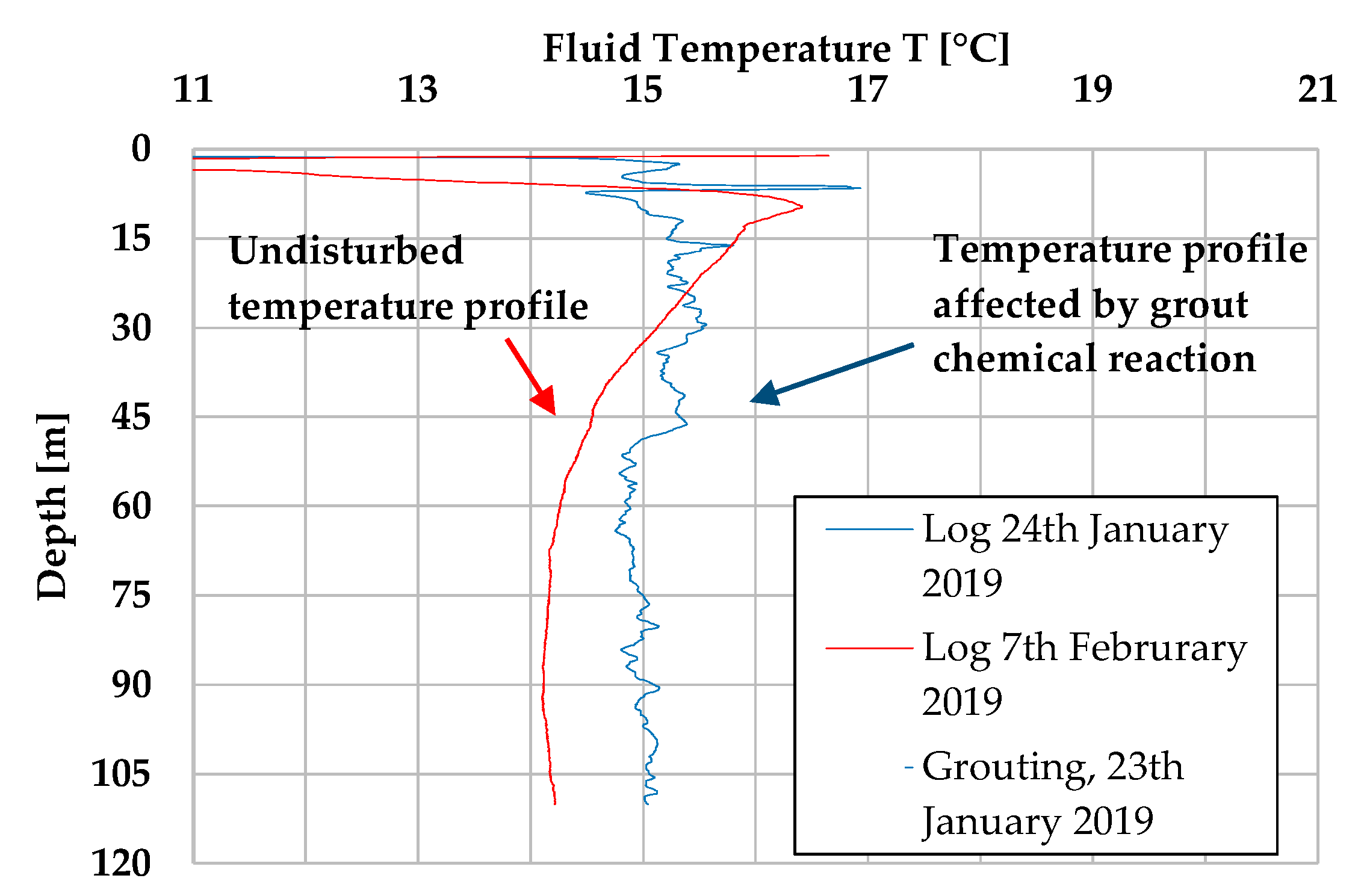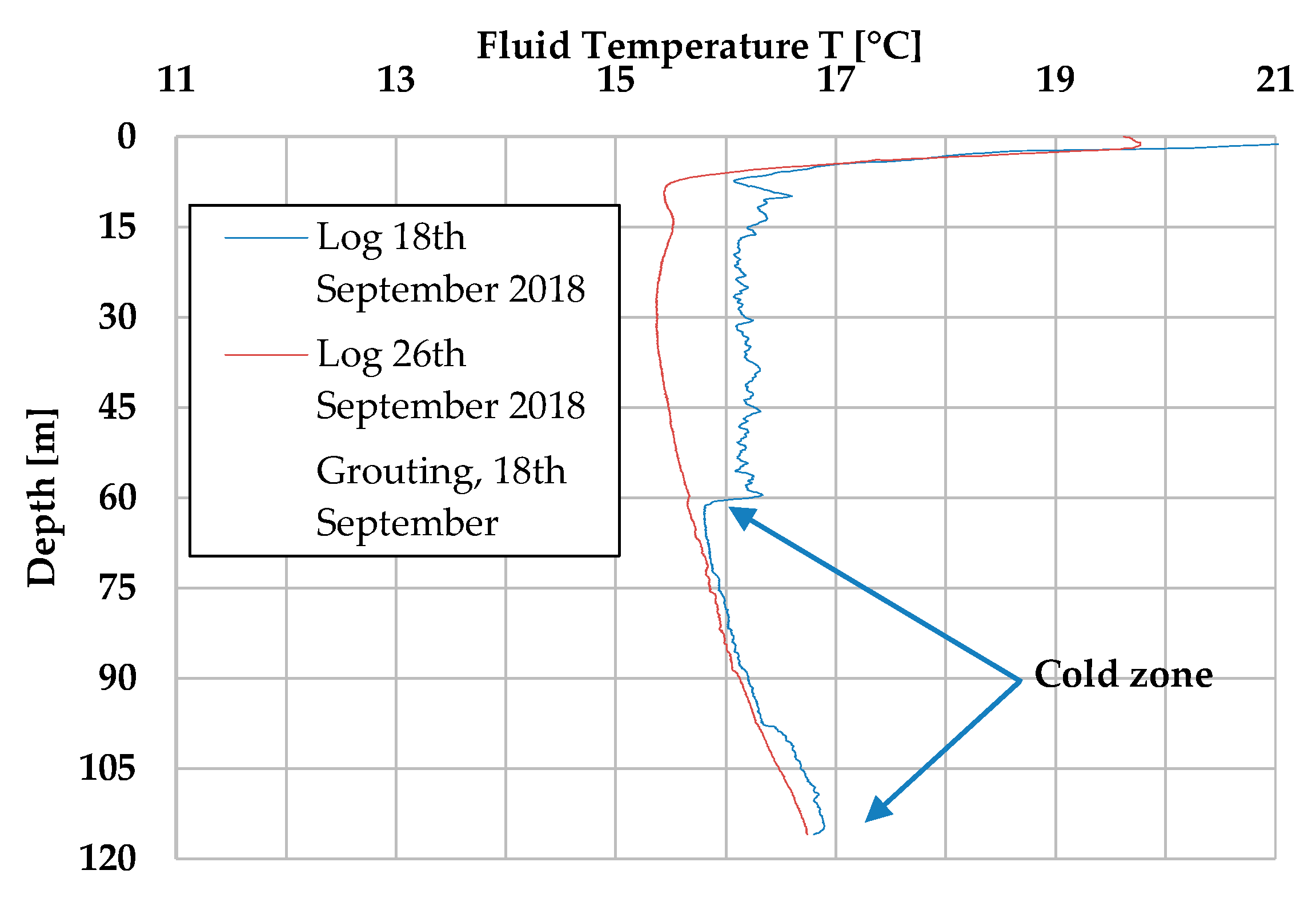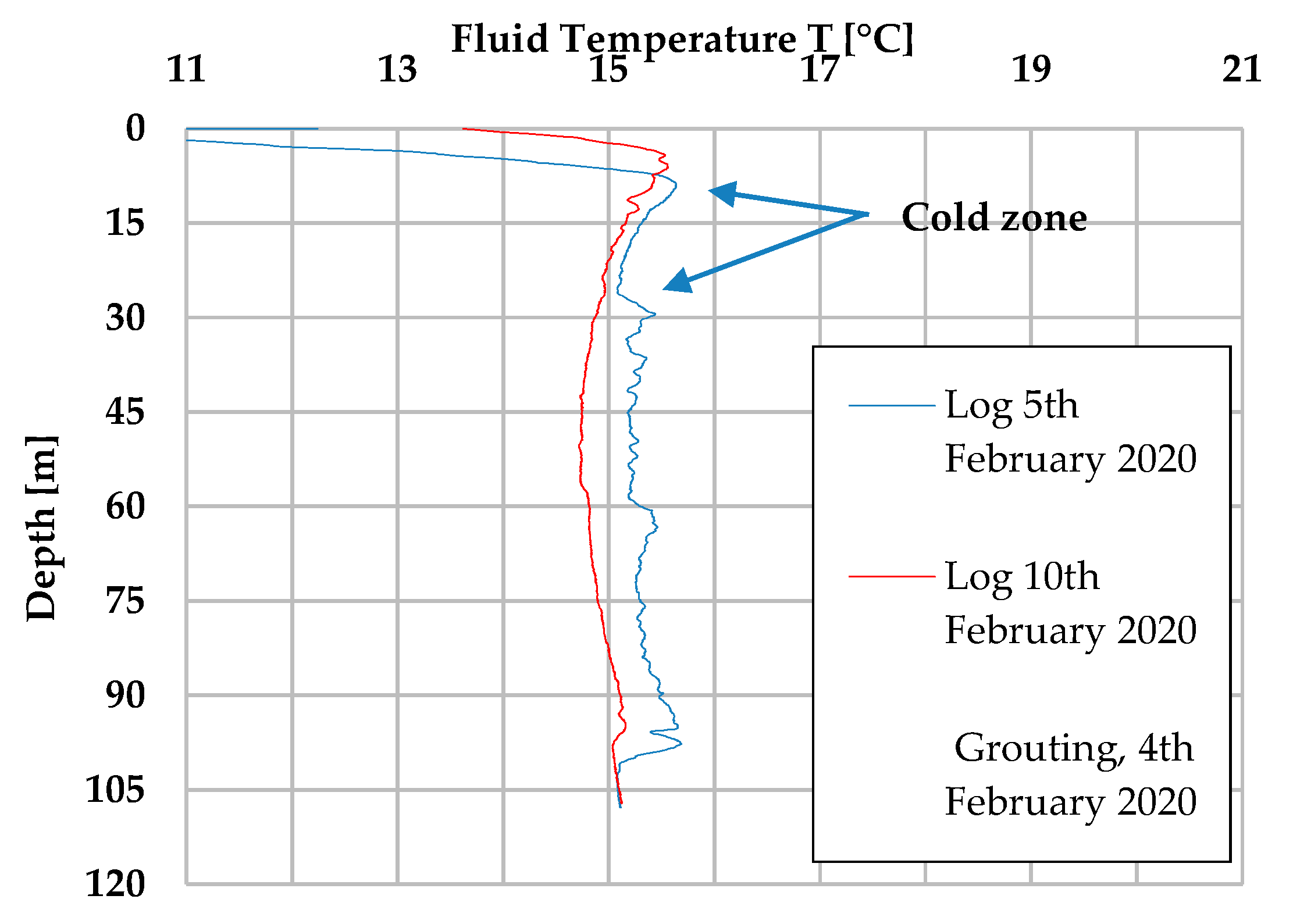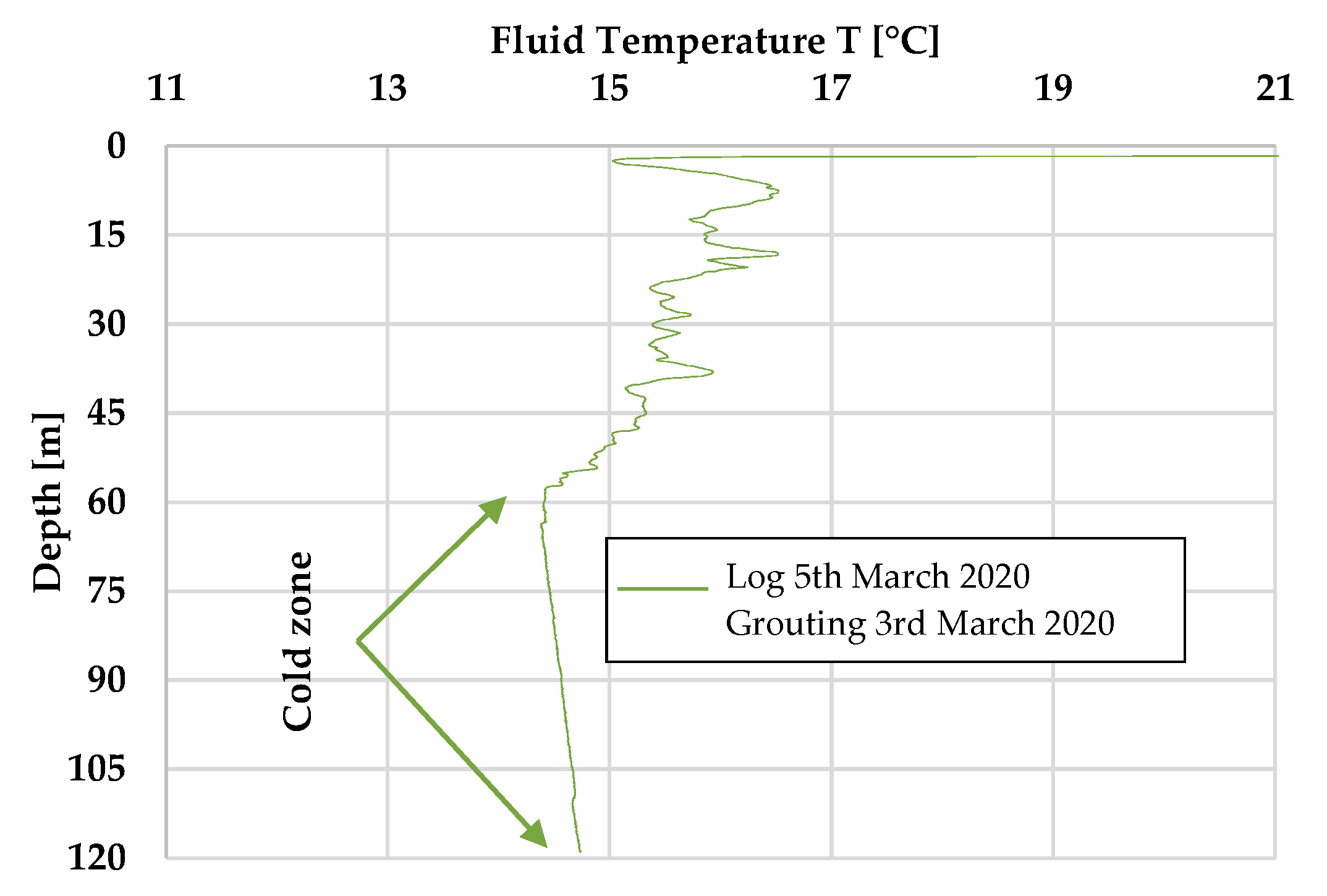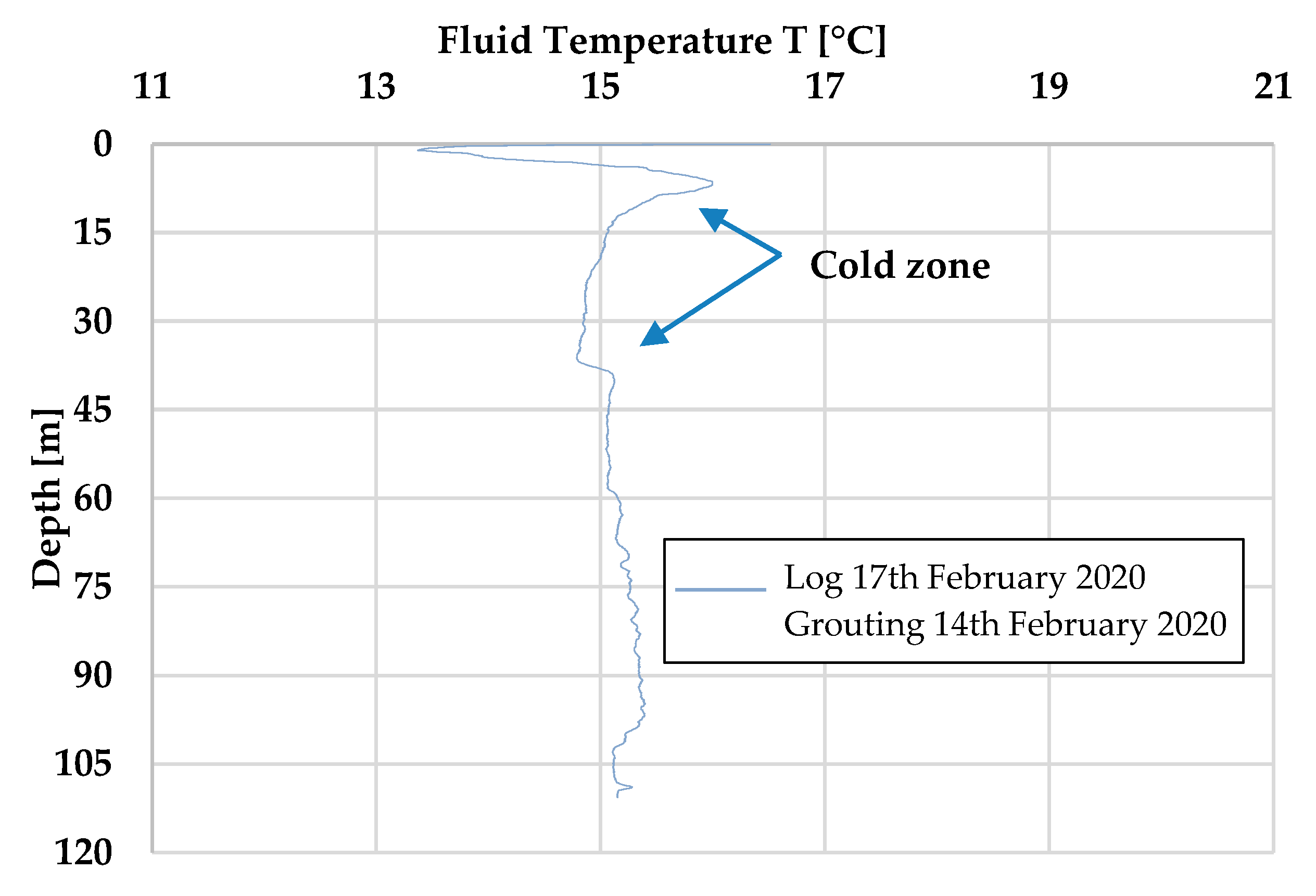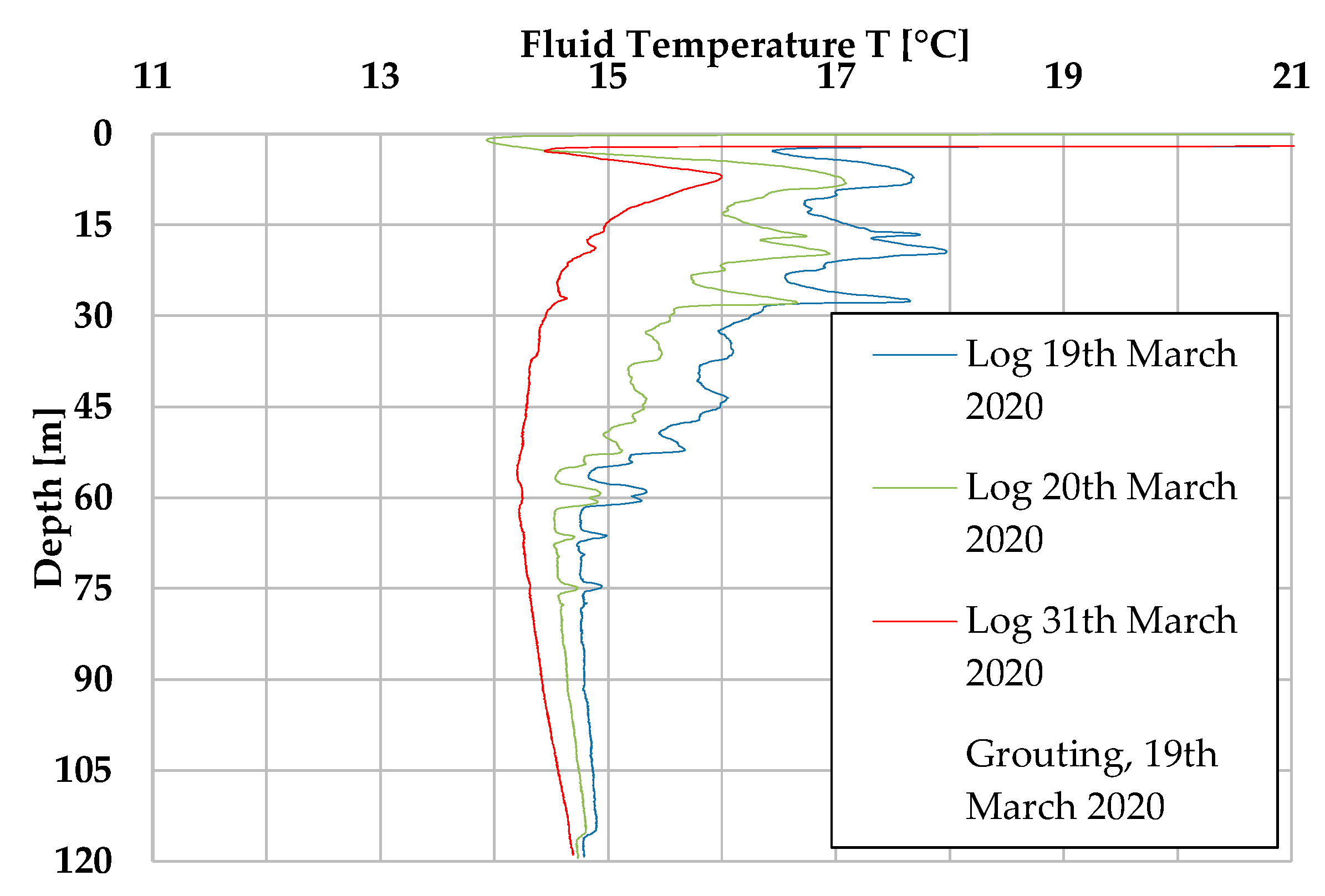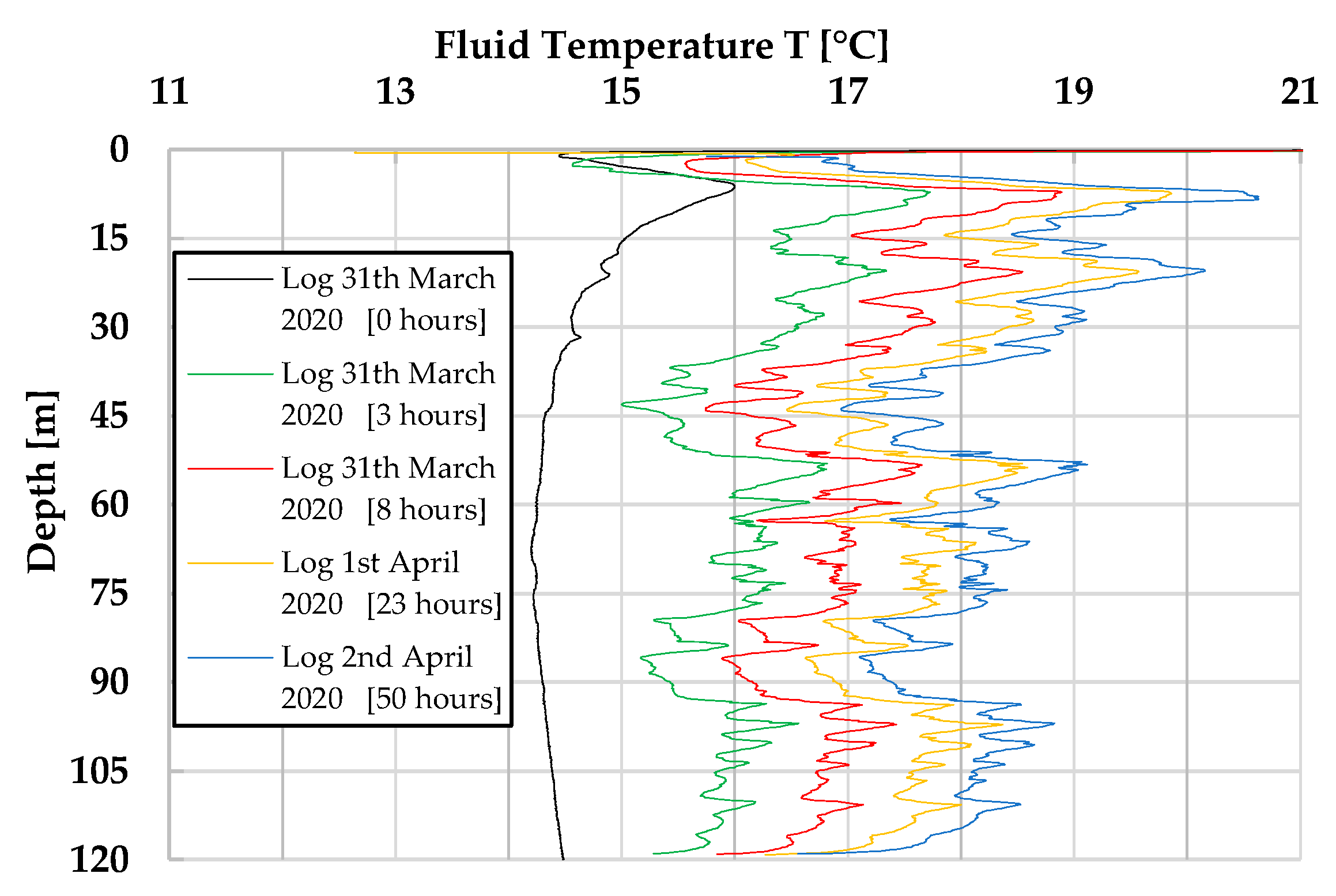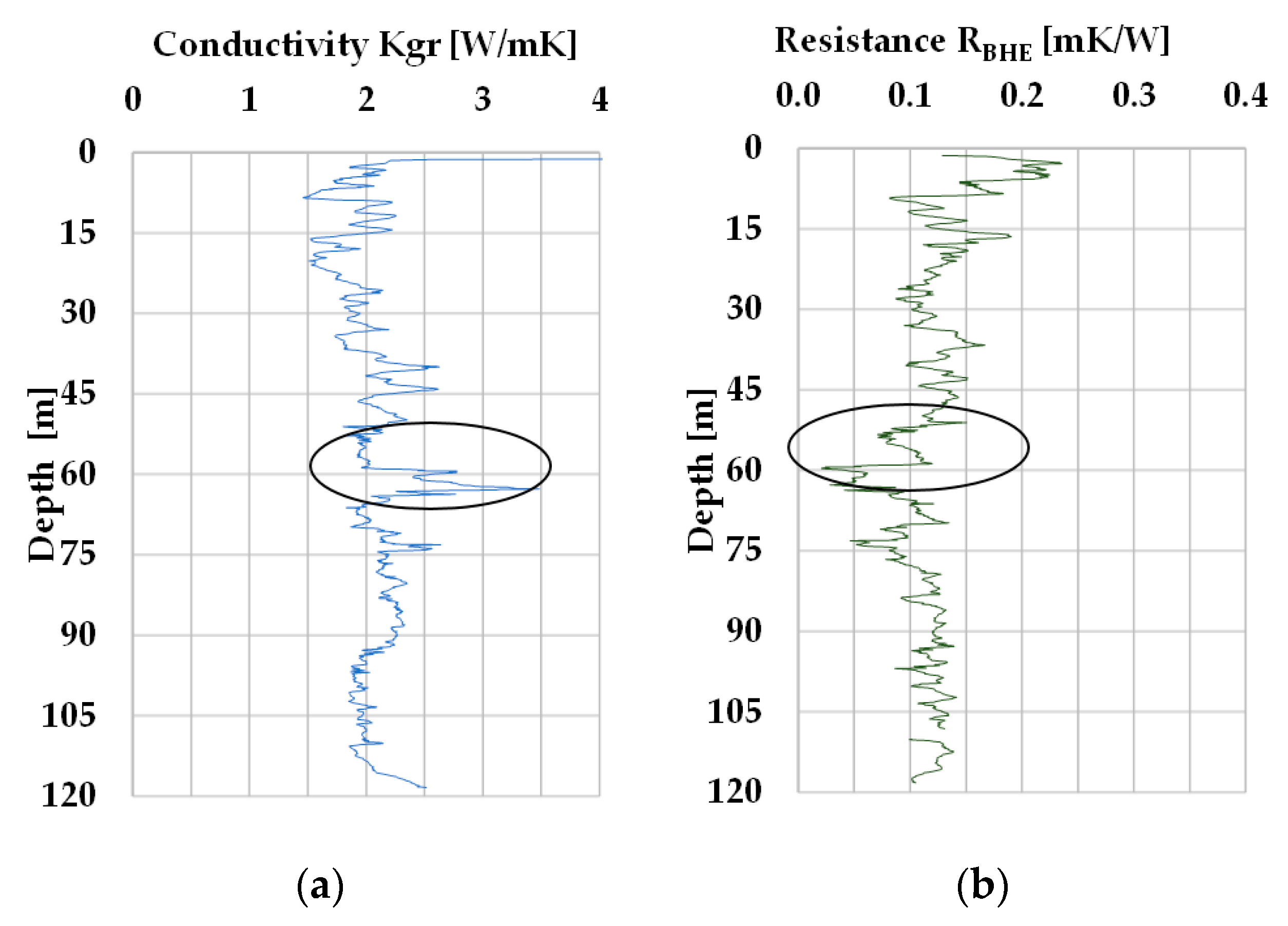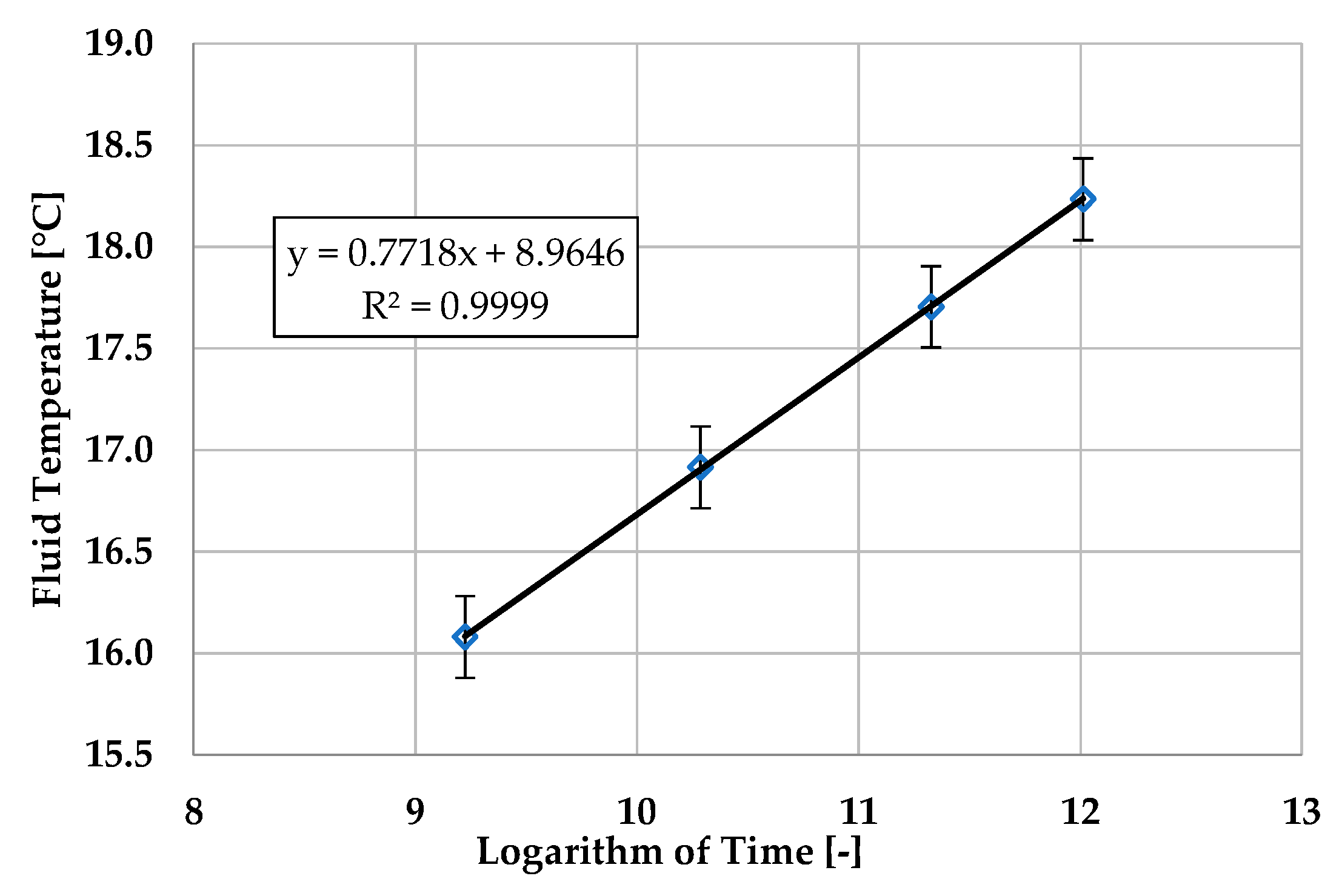1. Introduction
Nowadays, geothermal heat exchanger facilities are in rapid growth and the research for new instrumentation and surveying methods is in constant evolution in the direction of reliable and low-cost systems.
Borehole heat exchangers (BHEs) for ground coupled heat pump (GCHP) applications are the most popular technology in low enthalpy applications, where heat stored in the ground is exploited for heating purposes in building applications. In this context the knowledge of the geological, hydrogeological, and thermal conditions of the ground medium is fundamental for the system efficiency and economical sustainability. Ground thermal conductivity is one of these key parameters, since it controls the heat transfer rate between the BHE field and the ground mass [
1,
2,
3].
In addition to favorable thermal conductivity and specific heat, the presence of groundwater and the related advection phenomena can further increase the heat transfer performance of the BHE field [
4,
5].
The International Energy Agency (IEA ECES) [
6] and the Ente Nazionale di Unificazione (UNI) [
7] standards recognize the Thermal Response Test (TRT) as the best practice in order to estimate the ground thermal properties and from them to calculate the optimal length and distribution of BHEs. As it is well known, the TRT method allows the effective ground thermal conductivity (
kgr) and effective borehole thermal resistance (
Rbhe) to be estimated from temperature measurements at the BHE top inlet and outlet ports.
However, the standard TRT experiment is not able to provide detailed information on ground properties, since the test is not conceived for retrieving information about the heterogeneity of ground lithology and the presence of aquifers, thus leading to a bad long-term system performance and wrong BHE field design [
1,
8]. To define the optimum borefield geometry for the best trade-off between energy performance and investment costs (e.g., drilling and grouting), additional information on ground property distribution along the BHE depth are necessary [
9].
To address this lack of information, several tools have been developed in order to evaluate the depth-related ground properties along the BHE. For instance, a device developed by Martos et al. [
10] called Geoball consists of a wireless sensor with a spherical shape and embedded data logger temperature and position. The ball-shaped sensor has a density similar to that of the fluid, thus it is able to be carried by a flow inside the BHE pipe. The exact sensor location along the pipes can be calculated from pressure measurements during the sink of the sensor itself.
Commercial companies have started to realize similar devices. Among them, the enOware enterprise developed its integrated sensor (named GEOsniff, [
11]), a ball-shaped device able to record temperature and position while travelling along the pipe of a pilot BHE. This submersible sensor has a higher density than water, allowing it to sink along the pipes. To expel the sensor from the pipe, it has to be flushed out in a tank using a pump.
Haranzabal et al. [
1,
12] have tested and compared different sensors for distributed (along the BHE depth) measurements, including submersible sensors and optical fibers, confirming that travelling sensors inside the carrier fluid stream are suitable for temperature measurements along the BHE. Furthermore, according to the literature investigation [
1,
12] these sensors can assure good spatial accuracy, provided that the sinking speed and sampling time are correctly chosen.
Once the temperature values have been made available by such distributed measurements along the BHE depth, ground properties and even grouting characteristic estimations can be achieved with theoretical models able to describe the heat transfer phenomena along the BHE radius [
13,
14,
15].
The importance of a correct grouting during borehole heat exchangers installation is well known [
16,
17,
18]. The grout is used to seal and stabilize the borehole, providing a heat transfer medium between pipes and the surrounding ground. In addition, the grout is able to act as a barrier against groundwater movement and contamination in the vertical direction.
The grout affects clearly the effective borehole thermal resistance
Rbhe, as discussed in several studies [
13,
14,
15,
19,
20,
21]. Zeng et al. [
15] in particular obtained a complete set of equations for
Rbhe calculation and demonstrated that the U-tube shank spacing and grout thermal conductivity are the prevailing factors in determining the
Rbhe.
It is hence important to select the proper grouting material, optimizing the thermal conductivity with respect to the ground thermal one and considering also other grout properties such as the coefficient of permeability in the bulk state and, when bonded to BHE tubes, shrinkage, bond strength, wet-dry and freeze-thaw durability, leachability, exotherm, and the coefficient of thermal expansion. Since the late 1990s, research institutes [
22] and ground heat pump companies have developed different types of enhanced thermal grouts, the use of which is recommended in most design guidelines.
Hossein et al. [
23] provide a comprehensive review of backfill materials in geothermal applications. The six most common grout types used in geothermal installations are pure bentonite, neat cement, cement-bentonite grouts, bentonite/sand mixtures, cementitious grouts containing fillers (such as PFA, Pulverized Fuel Ash [
24], or micro-fine colloidal silica and colloidal lime or others), and graphite-based materials [
25]. There is also recent development in the addition of phase change materials (PCM) [
26].
It is also very important to properly backfill the borehole during the installation, as the IGHSPA Association recommends in its specific grouting dedicated manual [
16]. Improper grouting has a negative impact on the heat transfer process, modifying the thermal behavior of the geothermal field with respect to the design conditions, resulting in a worse energy performance of the geothermal heat pump system and, in severe cases, critical system operation problems.
Philippacopoulos and Berndt [
27] investigated the influence of debonding in ground heat exchangers. They found that debonding at the backfill/pipe interface has greater significance than debonding between grout and surrounding formation. Chen and Mao [
28] studied the influence of grout backfilling, estimating the thermal resistance through a 2D steady-state heat conduction model in four different cases: (1) fine backfilling, (2) porous backfilling, (3) hole-wall delaminating, and (4) pipe-wall delaminating. The comparison of performance shows that the heat transfer rate per unit length at the borehole wall decreases by 6.3%, 41.5%, and 78.4%, respectively, in the case of porous backfilling, hole-wall delaminating, and pipe-wall delaminating, with pipe-wall detaching having the worst impact on the BHE performance.
It is quite difficult to find a way to check and control the correct BHE grouting. Considering that most grouting materials contain cement, it is possible to use the hydration reaction to detect the quality of grouting by in situ measurements because the grouting hardening reaction (hydration) is exothermic. The hydration temperature profile depends on the type of grout, the water content, the presence of air or other materials, and the thermal transport potential of the surrounding ground, as Suibert Oskar Seibertz et al. [
29] discussed based on their field and laboratory tests.
If a simple and quick way to monitor the heat of hydration effects could be found, it would be possible to complete the BHE test installation with a grouting quality investigation. Thus, devices such as submergible sensors could be a good solution for this purpose too.
The present work is aimed at developing an experimental technique based on distributed temperature measurements along the depth of pilot BHEs in order to exploit the exothermic hardening reaction of grout for assessing the presence of thermal anomalies along the heat exchanger depth. The measurements refer to a large series of real BHE installations drilled in Italy, and in this sense the present investigation represents the very first one on a large scale devoted to the thermal analysis of grout material in the early stage of BHE installation. It is here demonstrated that grouting chemical heating can be exploited by distributed temperature measurements for precisely detecting ground anisotropies at vertical layers and grouting defects. An additional series of experiments is here discussed for assessing the influence of the hydration heating on TRT experiments, including the estimation of the time needed for assuring a reliable estimation of the ground undisturbed temperature.
2. Thermal Response Test Theory
Ground thermal properties are typically inferred during a TRT experiment, during which a constant flow rate of water is circulated in a pilot BHE while a constant heat transfer rate is supplied to the carrier fluid by some electric heater inside the TRT machine, which is located at the ground surface.
The measurements of the inlet and outlet fluid temperatures at the pilot BHE allow the ground thermal conductivity to be estimated based on the heat transfer rate and undisturbed ground temperature knowledge, both estimated during the experiment itself. The method was first proposed by Palne Mogensen [
30], a Swedish Engineer who first realized that the Infinite Line Source Model (ILS), usually applied to small samples at laboratory level, could be applied to the large volumes of ground surrounding a borehole heat exchanger. Mogensen conducted his own TRT experiments with a refrigeration machine able to extract heat from the carrier fluid at an almost constant rate. Mogensen also realized that the ILS model and its log linear approximation could be applied for describing the fluid temperature evolution in time during the TRT experiment, provided that an extra term to the ILS expression was added (“the thermal transfer resistance” in the Mogensen paper, later by other researchers “the effective BHE resistance”,
Rbhe).
After Mogensen, a series of researchers applied the method and realized dedicated equipment. Among them, one can refer to Gehlin [
31], who first realized the first mobile TRT machine; Austin [
32], who first performed TRT experiments in the US; Acuna and co-workers [
33], who first employed distributed sensors along the BHE in order to infer the ground thermal properties along the ground depth; and Fossa et al. [
34], who described the possibility of working at a non-constant TRT heat transfer rate and the advantages in terms of the property estimates of such pulsated experiments. Very recently, Morchio and Fossa [
35] tackled the problem of TRT analysis with deep boreholes (up to 800 m), when the geothermal gradient effects can lead to temperature crossing in the bottom part of the heat exchanger. From the same research group, the TRT analysis in terms of proper temperature response factors is further extended to geothermal pipes [
36]. Franco and Conti [
37] present an updated and comprehensive review of the various TRT types and explore the perspective to combine TRT and routine geotechnical tests.
The Infinite Line Source (ILS) was first described with reference to ground heat exchanger problems by Ingersoll et al. [
38] in their book. The ILS approach provides an analytical solution of the ground’s temperature evolution in time and radial space when a constant heat transfer rate (per unit length
) is applied to infinitely long linear sources buried inside an infinite medium. In dimensionless form, the ground temperature T can be expressed as an excess with respect to the undisturbed value
:
where
kgr is the ground thermal conductivity and
For is the Fourier number based on the radial distance from the line source,
r. In the above expression, the complex Exponential Integral
E1 can be accurately approximated by simple series expansions, as discussed, for example, by Fossa [
39]. Back to the Mogensen intuition, once the interest is on the fluid temperature and the fluid is circulating inside a BHE pipe which locates some
rb (borehole radius) from the ground medium (where ILS is expected to apply), additional thermal resistance must be added to the ground thermal resistance
Rgr:
This additional thermal resistance is the above-mentioned borehole effective resistance
Rbhe (after Eskilson definition, [
40]). Moreover, one can adopt the second term truncated version of the
E1 expansion series, provided that the
Forb range of interest is higher than about 10 [
38]:
where
γ is the Euler constant. The final step is to rearrange the two thermal resistance model in a proper way in order to allow the
kgr estimation:
Equation (4) can be easily thought as a linear expression of the fluid temperature (as the inlet/outlet average outside the BHE) as a function of the logarithm of time. The new expression contains the line slope m and a constant, which in turn is a function of
Rbhe:
Finally, the ground thermal conductivity can be calculated from the estimate of slope m according to the expression:
For solving the above equations system, the undisturbed (initial) ground temperature Tgr,∞ is required, and it is usually inferred during the first part of the TRT experiment, when the carrier fluid is circulated without any heat injection or extraction (adiabatic part of the test).
The borehole thermal resistance
Rbhe is itself chained with
kgr, and its estimation is possible for any instantaneous fluid temperature value, such as:
It is apparent from the above set of equations that the correct estimation of both kgr and Rbhe is strictly related to the knowledge of the undisturbed ground temperature, which in turn is measured though the fluid temperature during the initial adiabatic part of the TRT run, hence provided that any heat source is present at this stage of the experiment.
3. Grouting and Hydration Reaction
The hydration of Portland cement refers to a series of chemical reactions taking place within a water–cement system: the silicates and alumina react with water to form hydration products. There are four major mineral compounds in Portland cement: C3S, C2S, C3A, and C4AF, which are hydration exothermic reactions which differ significantly from each other.
The heat generated by the cement’s hydration raises the temperature of the grout material inside the BHE. An example of the rate of heat development versus hydration time curve is illustrated in
Figure 1 [
41], where it is possible to note the typical five stages of hydration reaction: the initial reaction, the induction period, the acceleration period, the deceleration period, and the steady state condition.
The heat of hydration influences the temperatures inside and around the BHE during the first days after installation, depending on the grout mixture properties and chemical composition and in particular its cement percentage. The time required for the ground to return to an approximately undisturbed state after the installation was not enough systematically investigate. Kavanaugh [
42] recommends to wait before performing a TRT for at least 24 h after drilling, and at least 72 h if cementitious grouts are used. The ASHRAE Fundamentals Handbook [
43] TRT guidelines prescribes the following: “A waiting period of five days is suggested for low-conductivity soils [k < 1.7 W/(m·K)] after the ground loop has been installed and grouted (or filled) before the thermal conductivity test is initiated. A delay of three days is recommended for higher-conductivity formations [k > 1.7 W/(m K)].” The Italian standard UNI 11466 [
7] at nomenclature, reports identical recommendations.
With distributed temperature measurements performed immediately and during the first hours after BHE installation and grouting (i.e., during the hardening process), it is thus possible to observe how the hydration reaction affects the ground temperature profile and therefore investigate the quality of the grouting itself. In fact, in the presence of a small rise in temperature over time at a specific ground layer with respect to other layers, it is thus possible to guess there is poor grouting at that position.
It is worth noticing that the hydration reaction does not affect the medium and long term performance of the BHE and the coupled geothermal system, since the hydration heat input inside the ground is very small (compared to GCHP operations) and very short in time (a few days). It is, however, important to stress that any TRT must not to be performed until the hydration reaction has ended, and to this aim the knowledge of the hydration phenomenon duration is fundamental. Furthermore, a thermal analysis like the present one during the hardening process can reveal poor grouting at specific ground layers, a condition which in turn yields higher values of Rbhe with respect to the design values, thus worsening the long-term performance of the whole system.
4. Experimental Apparatus and Test Sites
In TRT experiments, the classic instrumentation employs electric heaters, a circulation pump, and proper sensors (e.g., RTD ones) for measuring the carried fluid temperature at the ground surface [
34].
The present investigation applies a different approach to TRT experiments which is based on the use of small submersible sensors, able to travel inside the carrier fluid along the BHE pipes while recording both the temperature and pressure for a hydrostatic estimation of the sensor position along the BHE depth. To heat the fluid and its surrounding ground by 20 W/m, a heating cable (5 mm external diameter) is here inserted inside the pipe. This cable is able to deliver a constant heat flux along the pipe length, and hence it can fulfill the basic assumption behind the Infinite Line Source model.
The heating cable is inserted along one branch of the U pipe, while the temperature measurements are recorded by the travelling sensor in another pipe leg. This method allows us to perform a distributed TRT, since the local measurements allow the depth-related ground properties to be estimated. The equipment used by Geo-Net is the submersible sensor (
Figure 2a) produced by
enOware GmbH [
11]. The equipment is composed by the so-called Validation Box (
Figure 2b), where data is downloaded from the floating sensor and processed for inferring ground related properties.
The sensor (
Figure 2a) has the shape of a small ball, 2 cm in diameter, equipped with both a thermometer and a pressure meter to estimate the depth position of the sensor when slowly moving inside the stagnant fluid inside the BHE pipe (
Figure 3). The accuracy of the sensor and its measuring chain is provided by the manufacturer: the temperature resolution is 0.01 K; it has a 95% accuracy, 0.2 °C temperature, and 1 mbar pressure [
11].
The third component of the instrumentation is represented by manufacturer software able to process the data and configure the sensor.
The conversion of pressure into depth preventively requires information about the BHE length and the offset water level within the pipe, together with the density of the fluid (in the present investigation tap water, 998 kg/m3). The sampling frequency has been set to 1 Hz in order to obtain one measurement every 0.1 m approximately.
The submersible sensor has a known density of 1700 kg/m³, and the external software is able to estimate the sensor falling time based on the fluid and pipe data.
The dataset collected by the logger is sent to its validation box and then to the software that converts the measurements.
When the temperature measurements are employed for TRT analysis, the Equations (1)–(7) are applied based on the knowledge of the applied heat flux provided by the heating cable. The calculation tool developed by the Authors is able to process measurements pertaining to given depths, thus inferring the ground conductivity kgr and the borehole effective resistance Rbhe layer by layer along the BHE depth for proper Forb windows.
Test Sites
The case studies presented in this paper refer to a series of real BHE fields located in northern Italy. All the measurements have been performed by the Geo-Net company. In the following, a series of identification codes will be employed.
Codes ASC-1 and ASC-2 refer to experiments carried out in Imola city (Italy, 44°20′29.057′′ N; 11°43′23.46′′ E). Codes TAS-1 and TAS-2 refer to another pilot BHE in the same city (44°20′50.64′′ N; 11°42′16.90′′ E). FAE-1 and FAE-2 are BHEs located in Faenza city (44°17′27.06′′ N; 11°52′3.85′′ E), and finally the PIS code refers to the city of Pistoia (43°57′5.59′′ N; 10°53′18.88′′ E).
A geological bibliography [
44], confirmed by the geological surveys, showed that the ASC-1/2, TAS-1/2, and FAE-1/2 areas belong to the same geological context, which is characterized by continental sedimentary deposits namely made by layers of gravel, sand, and silt. Concerning the PIS site, which is in Tuscany, the geological surveys have shown shale rocks (argillite) surrounded by sedimentary soils consisting of alluvial deposits.
The measurements refer to pilot BHEs constituted by double 32 mm U pipes, and they were performed between 2018 and 2020. All the boreholes are grouted ones, and the BHE nominal diameter is 152 mm. The BHE depth is 120 m both in the ASC and PIS tests, whereas the TAS and FAE experiments were performed with 110 m heat exchangers.
Regarding ASC-2, TAS-1/2, FAE-1/2, and PIS, the measurements refer to the assessment of the vertical ground temperature profiles at different times from grouting the borehole, and they represent a series of snapshots of how the hydration heat can affect the ground undisturbed temperature profile and how such profiles can be employed for an indirect estimation of grouting defects.
Concerning the ASC-1 experiment, a distributed TRT has been performed on one pilot heat exchanger. Such a TRT refers to a series of temperature measurements along the BHE pipe when the electric heater is releasing heat (at a constant rate) inside another pipe of the same BHE.
The adopted procedure was the following one. The TRT had a duration of more than 50 h, according to the recommendations available in [
7]. Before activating the heating cable, a temperature measurement is made with the travelling sensor to assess the undisturbed ground temperature as a function of the depth, z (time zero). At this point, the electric cable is powered and a constant in the time heat transfer rate is applied to the BHE. From that instant on, four more records (in the following, referred to as “logs”) are carried out after 3, 10, 23, and 50 h from the start of the heating part of the test. The heat transfer rate applied to the heating cable is 2400 W.
5. Results and Discussion
Preliminary measurements with the present experimental technique showed that after some 2 h from the beginning of the BHE grouting, a temperature perturbation can be detected along the BHE depth. This behavior lasts up to 2 or 3 days after the BHE by grout.
Figure 4 and
Figure 5 show the measured temperature profiles during the grout chemical reaction and after the end of it, some 10 days later. It can be noticed from both figures at the FAE site that the temperature increase (with respect to the undisturbed situation later in time) is almost uniform along the BHE depth, suggesting that the heat release rate per unit depth is uniform. It is worth noticing that, provided that the volumetric heat release is uniform as well, this temperature uniformity can suggest that the grouting was uniform in volume all along the vertical direction.
A different situation can be observed from inspecting
Figure 6 and
Figure 7. Here, the measurements pertain to the PIS and TAS sites, respectively. In particular,
Figure 6 shows a zone in the bottom BHE part where the temperature does not change during the grout hydration period. The same can be observed in
Figure 7 at the BHE upper section. In both figures, this behavior has been named the “cold zone”, which in the experiment described in
Figure 6 is related to depths from 55 m on. The presence of cold zones can be observed in
Figure 8 and
Figure 9 as well in the TAS and ASC measurements.
The presence of cold parts along the BHE depth has to be related to a lower local heat rate or to the absence of it. Furthermore, these low temperatures cannot be ascribed to local heat removal phenomena (e.g., advection), since all the measurements are made inside the grouted volume, which the pipes carrying the electric cable and the travelling sensor are embedded in. As a consequence, the only possible explanation (or better, the more plausible one) is that any cold zone corresponds to a poor grouting, with the presence of air or water pockets.
In order to perform a reliable distributed TRT, it is necessary to record the temperature values when the hydration reaction is completed and the extra heat effects have vanished. To establish when the TRT experiment can be started, several temperature logs with the submersible sensor have been performed. This procedure is the one described in
Figure 10 for the ASC site.
Figure 10 shows that the hydration heat is active in the first days from grouting and that the undisturbed condition is reached in some 12 days (red curve).
Figure 11 shows the measurements in the ASC-1 experiment after the complete decay of any hydration effect. In this case, the distributed TRT experiment lasted 50 h, during which the travelling sensor was inserted 4 times inside the pipe for recording the temperature and pressure. The measurements have been recorded approximately every 0.1 m, and the complete record hence contains thousands of data points. By performing the analysis described by Equations (5)–(7), it was possible to infer the ground thermal conductivity and borehole thermal resistance at each depth position from the slope and intercept of the temperature profile when represented as a function of the logarithm of time.
Table 1 shows some 8 of 1200 rows of data recorded during the experiment described in
Figure 11. Columns 2 to 6 report the temperatures at several sampling times.
Columns A and B represent the slope m and intercept a of the ILS fitting line (Equation (6)), respectively. Furthermore, columns
kgr and
Rbhe provide estimates of the corresponding quantities at the given depth. Finally, the last row of
Table 1 shows the averages of each column.
Figure 12 shows the results of such an analysis. In particular,
Figure 12 shows that at a given depth layer (about 65 m), the estimated parameters are significantly different from those at other locations, thus allowing one to guess that that ground layer is characterized by groundwater circulation, which is able to enhance the local heat transfer in terms of a higher (apparent) ground conductivity.
Figure 13 finally shows the depth-averaged values of temperatures as a function of the logarithm of time. It can be observed that the experimental points well fit the regression line that is employed for the depth-averaged conductivity estimation. In particular, the fitting line slope (0.772) can be compared to the average of slopes (column A in
Table 1, bottom row) as obtained layer by layer.
The same analysis can be made in terms of the fitting line intercept (8.965 in
Figure 13) and the corresponding average value in
Table 1 (column B, bottom row). It is apparent from such a comparison that average
kgr and
Rbhe values as estimated with both methods are very similar, and their agreement is within 1%, thus providing a cross validation of the whole experimental procedure.
6. Conclusions
A series of experiments have been performed in a pilot BHE located in northern Italy during the period 2018–2020. Such measurements have been realized by means of submergible sensors able to record the local temperature along the BHE depth with a spatial step of less than 0.5 m and typically equal to 0.1 m. The temperature profiles along the vertical directions have been employed for a double analysis. The first part of the present investigation was devoted to assessing the effects of the hydration heat released by the grouting cement. It is here demonstrated that the grout chemical reaction can increase the local ground temperature close to the BHE pipes by up to 1.5 °C, and that this effect vanishes after a period ranging from 10 days to 2 weeks.
The same measurements have been employed for detecting the presence of “cold zones” along the borehole heat exchanger, where the local temperature does not change in time during the hydration period, when chemical heat release is expected.
The presence of cold zones is here ascribed to the lack of chemical reactions due to poor grouting or, in other words, to the presence of air, water, or gravel pockets in certain stretches of the BHE volume. In this sense, the present distributed measurement technique offers interesting opportunities for checking the quality of the grouting process in order to assess and forecast the BHE future performance.
The distributed temperature measurements have been finally employed for electrical heating TRT experiments. In this case, pipes are filled by water and one of them if fitted with the electric cable, while the other is used to sink the travelling sensor. It is here confirmed that the technique can be applied with the standard set of equations described by the ILS theory in order to estimate the local (depth related) values of both the ground thermal conductivity and the BHE thermal resistance.
